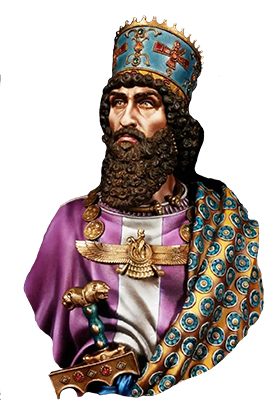
(Illustration)
The illustration of King Xerxes I as a man in his prime in a striking royal figure is correct in that he would have been in his late thirties in the year of the march. Born c. 518 BC, Xerxes reigned after the death of his father Darius I, in 486 BC until his own death in 465 BC.
When the Persians absorbed the Neo-Assyrian and Neo-Babylonian polities into their empire, the conquerors learned a great deal from them about the movement and supply of large armies over great distances, and put their acquired skills into practice. They certainly did not build roads in the Roman sense, but so improved on the old Assyrian routes, for example the two thousand kilometre “Royal Road” from Susa to Sardis, that they were able to move large numbers of troops and supply them across the wide expanses of their empire. No people could be less thalassic than the Persians, so they sensibly pressed their maritime Phoenician, Ionian and Egyptian subjects into building and manning commercial and fighting ships for their overseas ventures. This did mean however that they had to rely on the sometimes doubtful loyalties of their sea-going subjects.
Most wars, particularly ancient ones, were fought with the intention of making a profit from booty such as gold and slaves. With the backing of their huge wealth the balance sheet of invasion was of no importance to the Persians. They were well aware that Greece was singularly lacking in resources and sought only revenge for their defeat at Marathon, and in the process, burn Athens to the ground in retaliation for the destruction of Sardis by the Athenians during the Ionian rebellion in 498.14 Instead of planning an invasion with forces sufficient to ensure victory, they put together at huge cost, a grandiose exhibition of overwhelming strength. The numbers of their army and navy combined being much the same as the total population of Attica.
Xerxes failures caught up with him in the end. Weakened Achaemenid kings were in the habit of coming to a sticky end forwith, and Xerxes was no exception. He was stabbed in his bed and, like Caligula, was murdered by the commander of the royal guard.
The Acheamenid set a powerful and enduring precedent. Commanders of imperial bodyguards were a threat to empires, it turned out. The third Emperor of Rome, Caligula was also stabbed; by Cassius Chaerea Prefect of the Pretorian Guard, the few thousand troops quartered outside Rome tasked to protect the emperor. Caligula didn't die in bed like Xerxes, in a perversion of the phrase, but he died with his little boots on. Chaerea was in daily contact with the emperor as part of his duties, and conspired to kill him as he exited the palace theater.
The Achaemenid Empire was built and destroyed by conquest and endured another 150 years, until it died of natural causes, which one could fairly say in the mid fourth century BC, after battling Alexander's Macedonian phalanxes.
With Xerxes, the decay of the Achaemenid empire began. Again and again the state was afflicted by rebels (often rebellious satraps); and after a series of weak kings, the empire under Darius III Codomannus, the last Achaemenid king, was, in spite of its vast extent and many inhabitants, only a colossus on feet of clay which was not able to stop Alexander’s invasion. The Achaemenids’ role in universal history lies in their fashioning a model for centralized rule over various peoples with different customs, laws, religions, languages, etc. to the advantage and profit of all and their achievement of a unified Iranian nation for the first time (Encyclopaedia Iranica).
The Greeks considered Persians among barbarians, in reference to their unintelligible languages, which to a greek ear sounded like, bar-bar-bar. It could also signal xenophobia, since Greeks, unlike the Romans, who could speak Greek familiarly, never appear to have bothered to learn a foreign language.
Herodotus has a kinder view of foreigners, as his telling shows of the description of the sound of foreign words to his ears, as twittering birds.
With rare exceptions inscriptions on Persian monuments were not narrative accounts, and are devoid of details of military expeditions. Achaemenid history was left to their subjects and enemies to write about, who scarcely reveal the bureaucratic nature of the empire. Evidence is uneven in space and time.

